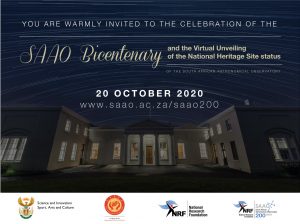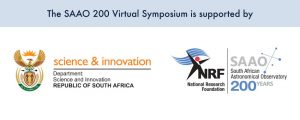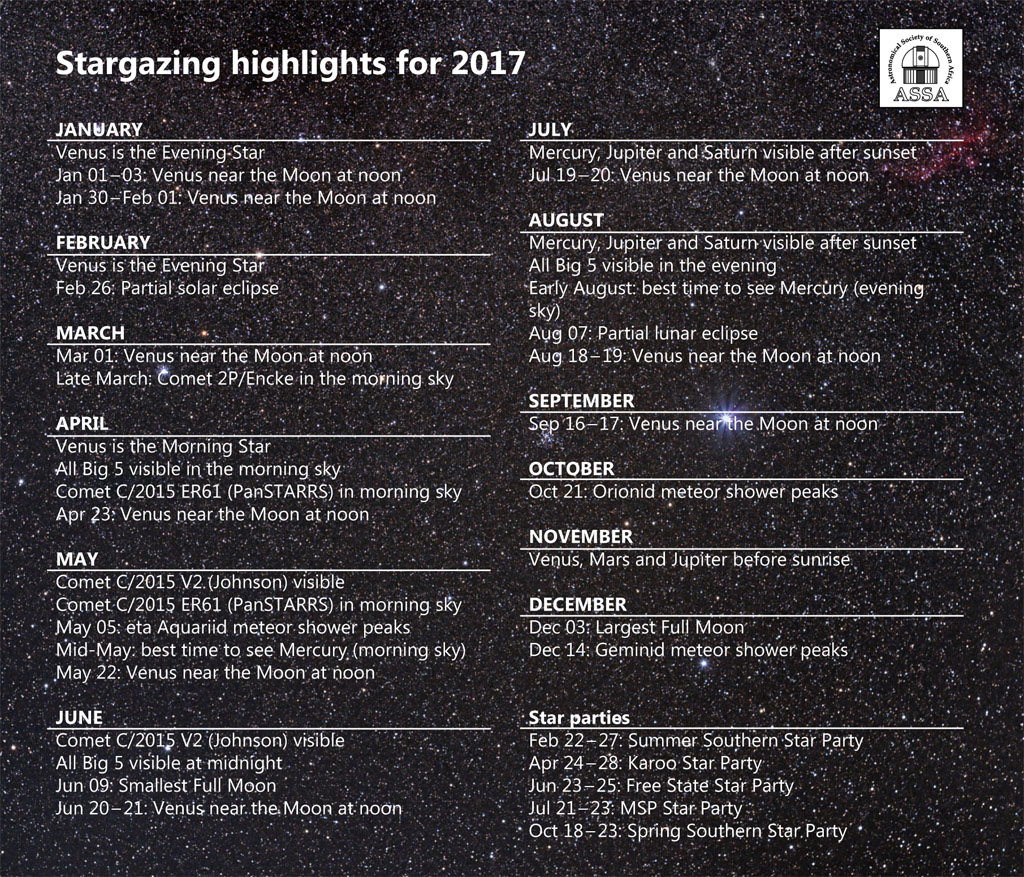Possible outburst of Andromedid meteors on 2 December
SAAO 200 Symposium
Only FIVE more days until the SAAO 200 Virtual Symposium!
If you haven’t registered yet you can still do so – just visit the registration site here. Remember, the Virtual Symposium, with more than three days of world-class presentations, is free to attend.
We kick off the SAAO 200 Virtual Symposium next Tuesday with the unveiling of the SAAO as a National Heritage Site. You can read the citation here. This honour puts the SAAO in the storied company of sites such as Robben Island, the Bushmanskloof Rock Painting Landscape, the Cradle of Humankind, and the Castle of Good Hope. How proud we are to join this exclusive membership, and to have African astronomy recognised in such a way.
Watch the live unveiling from 10:00 AM on Tuesday, 20 October at www.saao.ac.za/saao200.
Thereafter, our scientific programme is literally a three-day celebration of African astronomy, going right back to its very origins. Do join us. Who knows, one of the speakers might one day be a Nobel Prize winner.
Please read on for more about some of the excellent speakers that will be contributing to the programme.
Take care, stay safe, and “see” you soon,
The SAAO Virtual Symposium Team

Due to the generous support of the Department of Science and Innovation we are able to offer free attendance at the SAAO Virtual Symposium. Nearly 400 astronomers, astrophysicists, researchers, cosmologists, historians, educators, stargazers, and more have signed up to attend. Have you?
If you haven’t signed up yet, don’t worry, there’s still time! Register soon, and why not remind a colleague by forwarding this newsletter.

The Symposium’s virtual platform is the Socio app – you can choose the mobile app to use on your mobile device or the web app to use on your laptop in a browser. Better yet – use both and choose the mobile app for interacting and discussing with fellow attendees and the web app to watch the sessions on a bigger screen.
It’s quick and easy to download and set up the mobile app and the web app to work in concert. Then you’ll watch the sessions from the comfort of your home or office and interact with other attendees on the Social Wall or in the Discussion Forum, and even ask questions of the speakers in the Q&A sessions. If you have any questions or concerns about virtual, just reach out to us on saao200@africanagenda.com and we’ll be happy to put your mind at ease.

The South African Astronomical Observatory is well known for the excellence in research that it supports and produces. With the additional generous support of the DSI for the Symposium, we have developed an outstanding scientific programme. In fact, the virtual platform allows us to offer even more expertise and a wider range of perspectives.

 Mr Anthony Mietas is from a small community in the Northern Cape, currently employed by the South African Astronomical Observatory (SAAO) in Sutherland as the Manager for the Southern African Large Telescope (SALT) Collateral Benefits program, focussing on education, public awareness, and outreach. Mr Mietas’ presentation, entitled “Socio-Economic Impact of SAAO and SALT”, will highlight what the NRF and SAAO have been doing in partnership with various stakeholders to make a meaningful impact to address the socio-economic challenges in Sutherland.
Mr Anthony Mietas is from a small community in the Northern Cape, currently employed by the South African Astronomical Observatory (SAAO) in Sutherland as the Manager for the Southern African Large Telescope (SALT) Collateral Benefits program, focussing on education, public awareness, and outreach. Mr Mietas’ presentation, entitled “Socio-Economic Impact of SAAO and SALT”, will highlight what the NRF and SAAO have been doing in partnership with various stakeholders to make a meaningful impact to address the socio-economic challenges in Sutherland.
 Professor Emma Bunce is Head of the School of Physics and Astronomy at the University of Leicester, and President of the Royal Astronomical Society (RAS). Serendipitously, the South African Astronomical Observatory and the RAS are sharing their Bicentenary in 2020. Professor Bunce’s talk will introduce a brief history of the RAS, the evolution of both its science and its methods of support for its community of Fellows, and highlight key current activities of the RAS as it celebrates 200 years of supporting and promoting the study of astronomy and geophysics.
Professor Emma Bunce is Head of the School of Physics and Astronomy at the University of Leicester, and President of the Royal Astronomical Society (RAS). Serendipitously, the South African Astronomical Observatory and the RAS are sharing their Bicentenary in 2020. Professor Bunce’s talk will introduce a brief history of the RAS, the evolution of both its science and its methods of support for its community of Fellows, and highlight key current activities of the RAS as it celebrates 200 years of supporting and promoting the study of astronomy and geophysics.
 Dr Rob Adam was appointed Director of the South African Square Kilometre Array (SKA) Radio Telescope project in 2016 and became Managing Director of the SA Radio Astronomy Observatory (SARAO) in 2017. Dr Adam’s presentation, entitled “An update on MeerKAT and progress towards the SKA”, will cover the current status of the MeerKAT observing programme and data processing systems as well as progress towards the construction of SKA-1.
Dr Rob Adam was appointed Director of the South African Square Kilometre Array (SKA) Radio Telescope project in 2016 and became Managing Director of the SA Radio Astronomy Observatory (SARAO) in 2017. Dr Adam’s presentation, entitled “An update on MeerKAT and progress towards the SKA”, will cover the current status of the MeerKAT observing programme and data processing systems as well as progress towards the construction of SKA-1.
 Dr Moses Mogotsi is a SALT (Southern African Large Telescope) astronomer, which involves observing at SALT and taking part in other aspects of telescope operations. He is also involved in the development of the SALT near-infrared IFU instrument. Give him something to do with star formation and the interstellar medium and he’ll probably be interested in it! Dr Mogotsi’s presentation, entitled “Multiwavelength Views of Feedback and the Baryon Cycle”, will discuss some of the major questions regarding the baryon cycle and star formation feedback and how they affect galaxy evolution, and will illustrate how multi-wavelength observations from facilities and instruments such as SALT, ALMA, WiFeS, MUSE, and MeerKAT are being used in these studies.
Dr Moses Mogotsi is a SALT (Southern African Large Telescope) astronomer, which involves observing at SALT and taking part in other aspects of telescope operations. He is also involved in the development of the SALT near-infrared IFU instrument. Give him something to do with star formation and the interstellar medium and he’ll probably be interested in it! Dr Mogotsi’s presentation, entitled “Multiwavelength Views of Feedback and the Baryon Cycle”, will discuss some of the major questions regarding the baryon cycle and star formation feedback and how they affect galaxy evolution, and will illustrate how multi-wavelength observations from facilities and instruments such as SALT, ALMA, WiFeS, MUSE, and MeerKAT are being used in these studies.
 Dr Rosalind Skelton is based at the South African Astronomical Observatory (SAAO) where she is a support astronomer for the Southern African Large Telescope (SALT) with a research focus on galaxy formation and evolution. Her group investigates galaxy formation processes and interactions in different environments, from the formation of low surface brightness galaxies to the most massive galaxies and large-scale structures in the universe. Dr Skelton’s presentation, entitled “The effects of environment on galaxy evolution”, will present the results of SAAO’s recent work looking at how galaxies are affected by their environments. She will discuss how the SALT is contributing to this field, complemented by other multi-wavelength facilities such as MeerKAT, the AdvancedACT survey, and the Hubble Space Telescope.
Dr Rosalind Skelton is based at the South African Astronomical Observatory (SAAO) where she is a support astronomer for the Southern African Large Telescope (SALT) with a research focus on galaxy formation and evolution. Her group investigates galaxy formation processes and interactions in different environments, from the formation of low surface brightness galaxies to the most massive galaxies and large-scale structures in the universe. Dr Skelton’s presentation, entitled “The effects of environment on galaxy evolution”, will present the results of SAAO’s recent work looking at how galaxies are affected by their environments. She will discuss how the SALT is contributing to this field, complemented by other multi-wavelength facilities such as MeerKAT, the AdvancedACT survey, and the Hubble Space Telescope.
Partial solar eclipse, 2017 February 26
There will be a partial eclipse of the Sun late on Sunday afternoon, Feburary 26. It will be visible from anywhere in South Africa. Find out more on our “Eclipse 2017” page.




